If you are planning on installing a new hard drive to your PC, then you need to make sure it is compatible with your motherboard in the first place. So are all hard drives compatible with all motherboards?
Well, the simple answer to that question is No! They are not all compatible. For a specific hard drive to be consistent, your motherboard must have the correct interface (SATA or PCIe), slots, and form factor for the drive bay (the physical placeholder where you would install the hard drive).
This can all be confusing for a newcomer; for this reason, you must first understand a few essential aspects of hard drives.
You must first understand the two interfaces that hard drives use.
- SATA
- PCIe
The second important aspect you need to understand is the different types of hard drives AND their form factors. There are three kinds of hard drives:
- Hard Disk Drives (HDD) – Use SATA Interface
- SATA Solid State Drives (SSD) – Use SATA Interface
- NVMe Solid State Drives (SSD) – Use the PCIe Interface
Again, the form factor is equally important for understanding the different hard drive types. For instance, a 3.5″ hard drive will NOT fit in a 2.5″ drive bay – even if your PC has the correct interface and port.
Let us now get into the details.
TABLE OF CONTENTS
Understanding SATA and PCIe Interfaces for Hard Drives
There are two virtual interfaces that storage drives use:
- Serial ATA (SATA)
- Peripheral Component Interconnect Express (PCIe)
SATA Interface
SATA is the most common interface used for hard drives. As you see below, this is the interface we use to connect the typical hard disk drives.
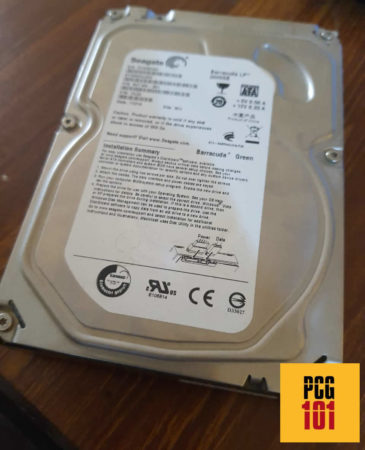
SATA hard drives require a SATA power cable and a SATA data cable.
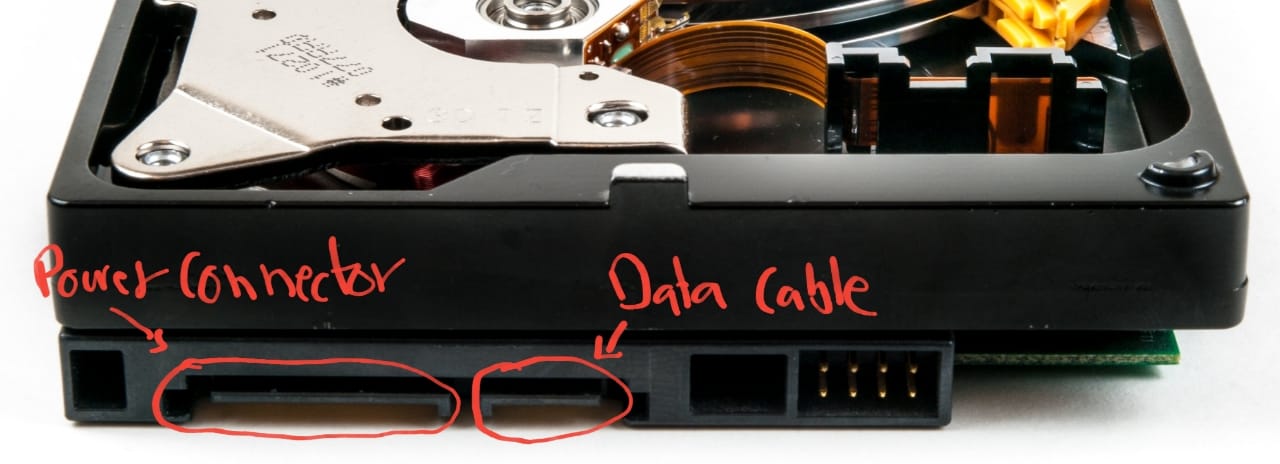
The SATA data cable connects to the motherboard’s SATA ports, and the SATA Power cable comes from the Power supply unit.
The SATA interface is slow. There are three versions of SATA ports. The latest is SATA 3. Each SATA version doubles the transfer rate.
- SATA 1 has a transfer speed of 1.5 Gbps or 187.5 MB/s
- SATA 2 has a transfer speed of 3.0 Gbps or 375 MB/s
- SATA 3 has a transfer speed of 6.0 Gbps or 750 MB/s
In reality, even the best hard disk drives have a max transfer rate of about 200 MB/s.
Only with SATA SSDs would you require a fast SATA 3 interface. More on this is below.
All motherboards have the SATA interface, and as far as desktops go, almost all motherboards have multiple SATA ports for connecting various SATA drives. Laptop motherboards typically have a single SATA port for hard disk drives.
TL:DR: SATA is the most popular interface. It is used to connect Hard Disk Drives and SATA SSDs.
PCIe Interface
PCIe interface is a high-speed interface. It is generally used to connect demanding expansion cards that generate much data, such as graphics cards.
PCIe interface uses PCIe lanes that connect to the PCIe slots on the motherboard. PCIe slots can be combined into varying amounts of PCIe lanes. An x1 slot, for instance, is small and only has a single PCIe lane. An x16 space, on the other hand, is the largest and can feature 16 PCIe lanes.
The transfer speed of the PCIe slots scales with the version and the number of lanes it has. So, for instance, an x4 space can handle four times as much data as an x1 slot.
Similarly, the transfer speed per lane doubles with every newer version of PCIe. Hence a PCIe 4.0 x4 slot is twice as fast as a PCIe 3.0 x4 slot.
The following table shows the speeds of various PCIe version and their corresponding slots.
| Version | x1 (GB/s) | x2 (GB/s) | x4 (GB/s) | x8 (GB/s) | x16 (GB/s) |
|---|---|---|---|---|---|
| 1.0 | 0.250 | 0.500 | 1.000 | 2.000 | 4.000 |
| 2.0 | 0.500 | 1.000 | 2.000 | 4.000 | 8.000 |
| 3.0 | 0.985 | 1.969 | 3.938 | 7.877 | 15.754 |
| 4.0 | 1.969 | 3.938 | 7.877 | 15.754 | 31.508 |
| 5.0 | 3.938 | 7.877 | 15.754 | 31.508 | 63.015 |
| 6.0 | 7.877 | 15.754 | 31.508 | 63.015 | 126.031 |
There is one class of storage drives that connect to the PCIe interface alone: NVME PCIe SSDs.
NVMe SSDs are super fast. To connect these to the motherboards, you require an M.2 slot. An M.2 slot typically connects to 4 PCIe lanes.
TL:DR: NVMe SSDs use the PCIe interface. If you have an NVMe SSD, you need a motherboard with a PCIe-enabled M.2 slot.
Also Read: How to Check SSD Compatibility With Laptop or Desktop?
Understanding Different Types of Hard Drives
To understand why hard drives cannot be compatible with all motherboards, you must first understand the different types of hard drives and their different form factors.
There are three popular types of hard drives:
- SATA Hard Disk Drive
- SATA Solid State Drive
- NVMe Solid State Drive
1. SATA Hard Disk Drives (HDD)
I talked about this earlier. These are the most popular drives we see on desktops and laptops.
The best part about these drives is that they are very cheap. Therefore, hard disk drives are the way to go if you need a large storage capacity.
There are two form factors for HDD:
- 3.5″ – used in desktops
- 2.5″ – used in laptops
3.5″ Hard Disk Drives
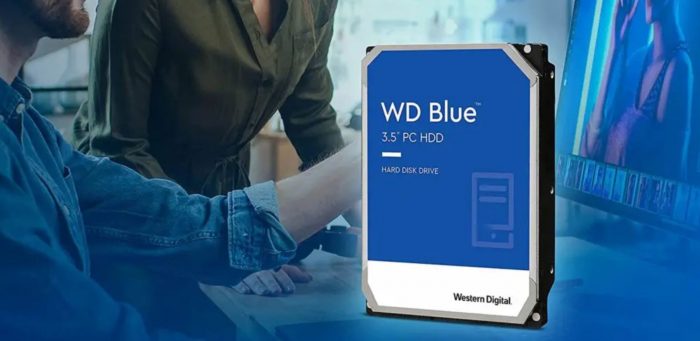
These are large, bulky, and found on desktops. They are the cheapest per GB, but due to their size and weight, they are not found in portable machines.
A 3.5″ hard drive CANNOT be fit into a laptop motherboard!
These reach maximum speeds of about 200 MB/s. Hence, their speed is their biggest drawback.
2.5″ Hard Disk Drives
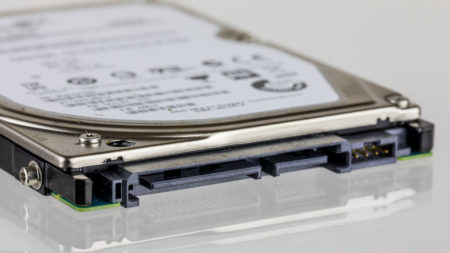
2.5″ hard disk drives are also very cheap but also relatively slow.
However, 2.5″ hard drives are smaller and consume much less power; hence they are great for laptops.
A laptop’s 2.5″ hard disk drive CAN fit in desktops. However, as mentioned earlier, a 3.5″ hard disk drive cannot fit in a computer.
Also Read: Can You Use a Laptop Hard Drive on a Desktop?
2. SATA Solid State Drives
SATA solid-state drives are SSDs that use the SATA interface. They should NOT be confused with NVMe (PCIe) SSDs.
SATA SSDs are much more expensive than HDDs, but they can reach speeds of up to 550 MB/s (2-3 times that of HDDs).
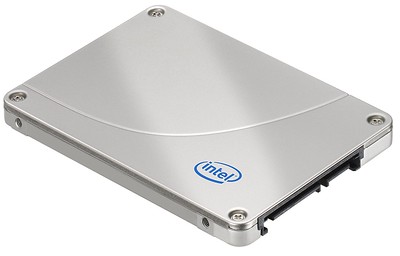
SATA SSDs connect to SATA ports, unlike NVMe SSDs that relate to the PCIe interface.
There are two form factors that SATA SSDs use:
- 2.5″ Form Factor
- M.2 Form Factor
The 2.5″ form factor is similar to the 2.5″ hard disk drives. These drives can fit in laptops and desktop motherboards. They require a SATA DATA cable and a SATA Power cable.
SATA SSD can also be found in the M.2 form factor. These SATA drives require an M.2 slot on the motherboard.

3. NVMe Solid State Drive

NVMe SSDs, aka PCIe SSDs, are the fastest drives you can get. They are also the most expensive. However, they have become the new storage standard as almost all newer systems offer NVMe SSDs.
They connect to an M.2 slot that typically connects to 4 PCIe lanes.
Therefore, their speeds can vary drastically depending on their generation.
A PCIe 3.0 NVMe SSD can top speeds of up to 3500 MB/s. The newer PCIe 4.0 NVMe SSD can top rates of about 5500 MB/s.
Also Read: What is the Difference Between SATA and SSD and HDD and NVMe?
Differentiating Between M.2 SATA SSD and M.2 NVMe SSD
Since NVMe and M.2 SATA SSDs use the same profile, you can determine between them by looking at the socket Key.
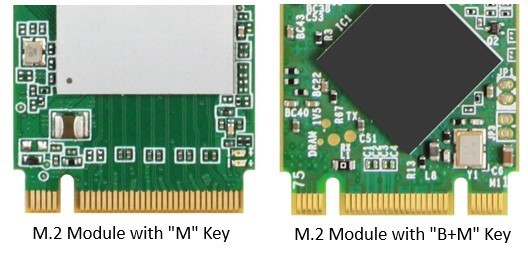
- NVMe SSDs use M Key
- SATA SSDs use B+M Key
So Are All Hard Drives Compatible With All Motherboards
Now that we know the different interfaces and the different drives, it will be easier for you to understand why not all hard drives are compatible with all motherboards
Incompatibility #1: 3.5″ Drives Will Not Work with Laptop Motherboards
For starters, a 3.5″ hard disk will not work with your laptop since its drive bay can supply enough power – let alone fit it inside its chassis.
Incompatibility #2: For M.2 SSDs, You Need a Free M.2 Slot
For both M.2 SATA and M.2 NVMe SSD to work, your motherboard needs to have a free M.2 slot.
If you have an older system, then chances are that your motherboard would lack an M.2 slot.
In other words, if you do not have an M.2 slot, then M.2 SSDs WILL NOT work UNLESS you get an M.2 PCIe expansion card.
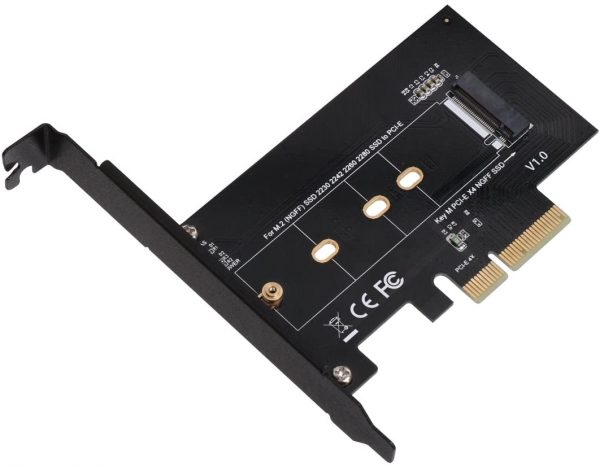
Incompatibility #3: You Need to Have the Right M.2 Port for the Type of SSD You Have

For an M.2 NVMe SSD, you must have an M.2 slot that conforms to the PCIe standard.
For an M.2 SATA SSD, you must have an M.2 slot supporting the SATA interface.
Take, for instance, the following ASUS Prime Z270-A motherboard specs; you can see here that the second M.2 slot does not support M.2 SATA SSDs, while the first slot can.
Incompatibility #4: For NVMe SSD, the PCIe Version of the M.2 Slot Matters
For a Gen 3 NVMe SSD to give you the best results, you must have a motherboard with an M.2 slot conforming to PCIe 3.0.
Similarly, for the newer Gen 4 NVMe SSDs, such as the Samsung Pro 980, to give you the best 5500 MB/s transfer speed, you will need a motherboard with an M.2 slot conforming to PCIe 4.0.
Also Read: Which Motherboards Support PCIe 4.0?
Installing a Gen 4 SSD in Gen 3 M.2 slot can reduce the transfer speeds by as much as half!
Also Read: Can You Use a PCIe 4.0 SSD On Your Existing Motherboard?
Incompatibility #5: Some M.2 Slots for NVMe SSD May Only Have Two PCIe Lanes
Earlier, I mentioned that an M.2 slot for NVMe SSDs connects to four PCIe lanes typically.
However, in rare instances, you may find a motherboard with an M.2 slot that only connects to two PCIe lanes.
For instance, the M.2 slot on ASUS Prime H310 connects only to 2 x PCIe lanes. Hence a Gen 3 NVMe SSD installed on this motherboard would operate at half its optimal speeds!

The following table summarizes different hard, hard drives, their typical speeds, and what they require to connect.
| Drive | Form Factor | Speed | Required Port/Cables | Remarks |
|---|---|---|---|---|
| Hard Disk Drive | 2.5″ | 200 MB/s max | SATA Data SATA Power | Suitable for laptop motherboards |
| Hard Disk Drive | 3.5″ | 200 MB/s max | SATA DATA SATA Power | Suitable for desktop. |
| SATA SSD | 2.5″ | 550 MB/s | SATA DATA SATA Power | Can be replaced with laptop primary hard drive. In desktops, can be connected to SATA ports |
| SATA SSD | M.2 | 550 MB/s | M.2 SATA Port | Has the M+B key |
| PCIe NVMe SSD Gen 3 | M.2 | 3500 MB/s max | M.2 PCIe Port (PCIe v3.0) | Has the M Key |
| PCIe NVMe SSD Gen 4 | M.2 | 5500 MB/s max | M.2 PCIe Port (PCIe v4.0) | Has the M Key |
Also, Read: Does My Motherboard Support NVMe SSD?
How Do I Know If My Hard Drive is Compatible with My PC?
Unless your PC is ancient, your PC will most definitely have the SATA interface.
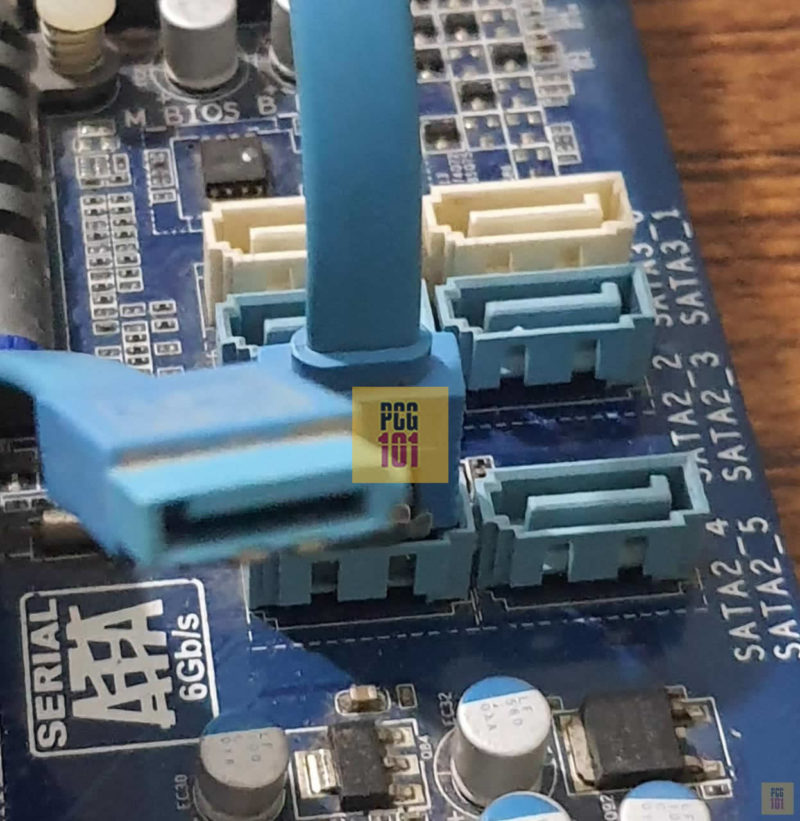
If you have SATA ports like those above, all SATA hard drives will work with your PC.
The only caveat is the version. The most current SATA version is 3.0. SATA hard drives connected to older SATA versions may perform slowly, BUT THEY WILL BE COMPATIBLE.
The compatibility depends on whether the PC is a desktop or a laptop.
You almost always have a single SATA slot for a 2.5-inch hard disk drive with laptops.
If you have an ancient system (15 years and older) that still use the PATA or Parallel ATA interface, then the SATA drives will NOT work.
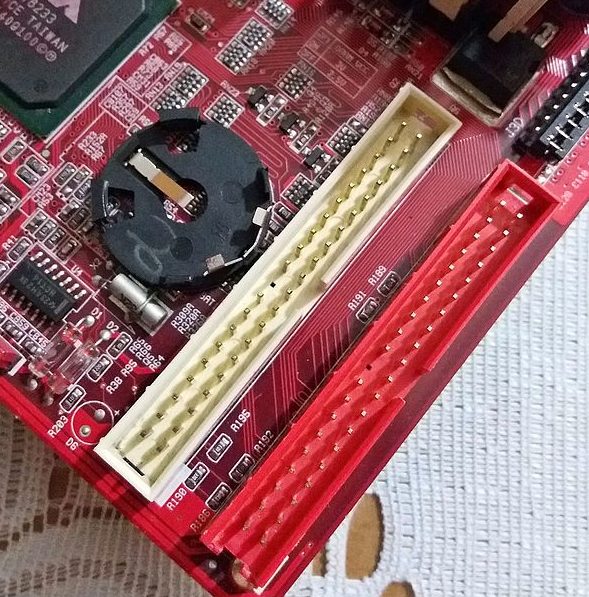
As for the M.2 slot, many older laptop and desktop motherboards may lack an M.2 slot.
But to confirm this and determine whether the M.2 slot can support SATA SSDs, NVMe SSDs, or both, you must refer to the spec sheet.
Final Words
So are all hard drives compatible with all motherboards? No, they are not. I have talked in detail about the different incompatibility issues you may encounter.
Therefore, the best way to figure out if a specific hard drive, particularly SSDs, is compatible with your motherboard or not, refer to the motherboard’s spec sheet.
FREQUENTLY ASKED QUESTIONS
1. How do I check if my hard drive is compatible with my motherboard?
To check if a hard drive is compatible with a motherboard, you can check the motherboard’s specifications and look for information on the types of hard drives it supports.
Typically, this information can be found on the manufacturer’s website or in the motherboard’s manual.
You can also check the hard drive’s specifications to ensure that it is compatible with your motherboard’s interface.
2. What should I do if my hard drive is not compatible with my motherboard?
If your hard drive is not compatible with your motherboard, you have a few options.
You can either replace the hard drive with a compatible one, or you can replace the motherboard with one that supports the type of hard drive you want to use.
If you’re unsure about what to do, you may want to consult with a professional or seek advice from the manufacturer.
3. Can I use a hard drive from a different manufacturer than my motherboard?
Yes, you can typically use a hard drive from a different manufacturer than your motherboard.
As long as the hard drive is compatible with your motherboard’s interface, it should work without any issues.
However, it’s always a good idea to check the manufacturer’s specifications to ensure compatibility.
4. How do I choose the right hard drive for my motherboard?
To choose the right hard drive for your motherboard, you’ll want to consider a few factors.
First, you’ll want to ensure that the hard drive is compatible with your motherboard’s interface (e.g. SATA, IDE, etc.). You’ll also want to consider the hard drive’s storage capacity, performance, and reliability.
It’s important to choose a hard drive that meets your needs and fits within your budget.
You can consult with the manufacturer’s specifications or seek advice from a professional if you’re unsure.

Is there any web tool to check compatibility with the laptop model number?
I mean if I have only laptop model number and all my laptops do not have HDD. I bought them all in the second-hand market. Now I want to insert HDD in my laptops. All my laptops are different models. How can I check which HDD is best and cheap for my lapdops?